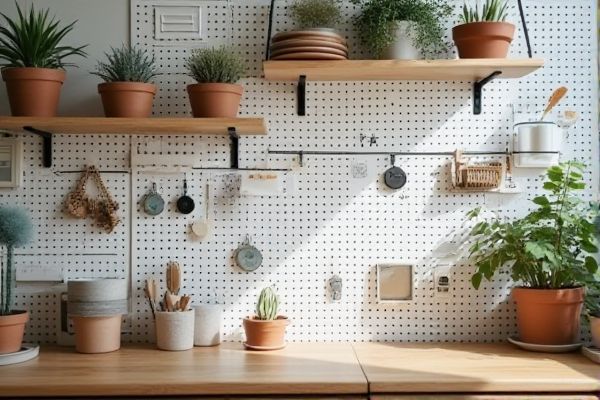
Wire grids offer a sleek, modern look with versatile hanging options and better visibility for items, while pegboards provide a classic, sturdy solution ideal for organizing tools with customizable hooks and accessories. Discover which option suits your storage needs best by reading the rest of the article.
Table of Comparison
| Feature | Wire Grid | Pegboard |
|---|---|---|
| Material | Metal wire, usually steel | Wood, metal, or plastic |
| Design | Grid pattern with open squares | Panel with evenly spaced holes |
| Installation | Wall-mounted or freestanding | Wall-mounted |
| Weight Capacity | High, depends on frame strength | Moderate, depends on material and anchors |
| Customization | Flexible with hooks, baskets, and shelves | Versatile with various peg hooks and accessories |
| Visual Appeal | Modern, industrial look | Traditional utility look, varies by material |
| Common Uses | Retail displays, tool organization | Workshops, craft rooms, garages |
| Cost | Typically higher due to metal construction | Usually more affordable |
Introduction to Wire Grids and Pegboards
Wire grids and pegboards are versatile wall organization systems widely used in retail displays, workshops, and storage solutions. Wire grids consist of a metal grid framework allowing for customizable hooks and shelves, providing sturdy support for various items. Pegboards are perforated wooden or metal panels featuring evenly spaced holes, ideal for hanging tools and accessories with specialized hooks and pegs.
Material Comparison: Wire Grid vs Pegboard
Wire grids are typically constructed from durable, coated metal wires that offer strong support and resistance to rust, making them ideal for heavier tools and items. Pegboards are usually made from medium-density fiberboard (MDF) or plastic, providing a smooth surface that is easier to paint but less robust under heavy loads. Metal wire grids allow for flexible accessory placement with hooks designed to latch securely, while pegboards require precise hole alignment for peg insertion, affecting load capacity and versatility.
Installation Process and Requirements
Wire grid installation involves mounting panels onto walls or using freestanding frames, typically requiring screws, anchors, and studs for secure attachment to support heavy tools or merchandise. Pegboard installation demands drilling holes in walls to insert anchors and screws, ensuring the pegboard is firmly affixed to studs for stability and weight support. Both systems require precise measurements and level alignment, but wire grids offer more flexibility with modular panels and hanging accessories compared to fixed pegboard configurations.
Customization and Versatility
Wire grids offer superior customization with modular panels that can be easily rearranged and combined to fit various storage needs, while pegboards provide versatile hook options for hanging tools and accessories but are limited to fixed panel sizes. Your choice depends on the adaptability required; wire grids excel for dynamic spaces needing frequent layout changes, whereas pegboards work well for stable setups with uniform tool arrangements. Both systems enhance organization, but wire grids provide more flexibility for evolving storage demands.
Weight Capacity and Durability
Wire grids offer superior weight capacity, often supporting heavier tools and equipment due to their robust metal construction and reinforced grid design. Pegboards, typically made from wood or fiberboard, have lower weight capacity and may warp or crack under heavy loads, impacting their durability. Wire grids resist bending and corrosion better, making them a longer-lasting option for heavy-duty storage needs.
Aesthetic and Design Options
Wire grid panels offer a sleek, modern aesthetic with clean lines and transparency that complements contemporary interiors, while pegboards provide a more traditional, utilitarian look with a solid surface available in various colors and finishes. Wire grids allow for flexible arrangement of hooks and accessories, creating open, customizable displays that emphasize minimalism and lightness. Pegboards, with their uniform holes and sturdy backing, enable precise placement of pegs and shelves, making them ideal for organized, visually consistent setups suited for workshops or craft rooms.
Space Efficiency and Organization
Wire grids maximize space efficiency by offering adjustable hooks and shelves that can be easily repositioned to accommodate various items, making them ideal for dynamic storage needs. Pegboards provide customizable organization through evenly spaced holes that allow for versatile placement of pegs and accessories, streamlined for tools and small objects. Both solutions optimize vertical space, but wire grids typically support heavier loads while pegboards excel in versatility and detailed arrangement.
Maintenance and Longevity
Wire grids require minimal maintenance due to their corrosion-resistant coatings, making them durable for long-term use in humid or outdoor environments. Pegboards, typically made from wood or MDF, may need regular sealing or repainting to prevent moisture damage and wear over time. Choosing a wire grid ensures your storage system remains sturdy and low-maintenance, enhancing longevity without frequent upkeep.
Cost Analysis: Wire Grid vs Pegboard
Wire grid systems typically offer a lower initial cost compared to pegboards, making them a budget-friendly option for flexible displays and storage. Pegboards, although sometimes more expensive upfront, provide greater durability and customization with various hooks and accessories, potentially reducing long-term replacement costs. When evaluating your storage needs, consider both the upfront price and maintenance expenses to determine the most cost-effective choice for your space.
Best Uses and Recommended Applications
Wire grids are ideal for retail displays, offering versatility and easy customization to showcase merchandise such as clothing, accessories, and home decor. Pegboards excel in workshops and garages, providing organized storage for tools and small parts with their peg hooks and accessory compatibility. Both systems optimize space, but wire grids suit dynamic retail environments while pegboards prioritize functional, accessible organization in workspaces.
 homyna.com
homyna.com